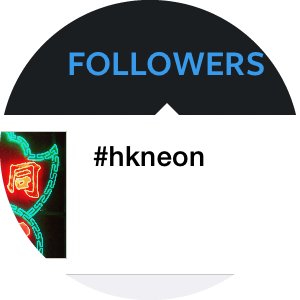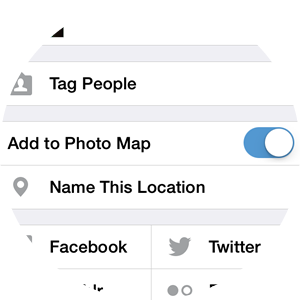Technological FoundationsBuilding on the Geissler tube and other earlier inventions, the American Daniel McFarlan Moore develops the ‘Moore lamp’. 1 A predecessor to neon and fluorescent lights, it is made by filling vacuum-sealed glass tubes with nitrogen or carbon dioxide; the gas emits a white glow when charged by an electrical current. 2
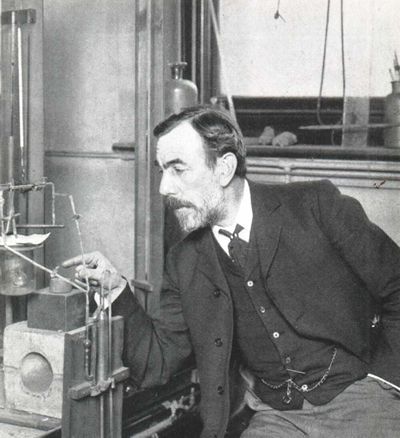
Filling a gap in the Periodic Table, British chemist and future Nobel Prize winner William Ramsay discovers neon gas in ‘a blaze of crimson’ in his London laboratory. (Ramsay is also the discoverer of other noble gases — argon, helium, krypton and xenon — which will later be used in neon lights.) However, Ramsay’s aims are scientific rather than commercial; more than a decade will pass before practical applications for neon are found. 3
Moore tubes are installed commercially for the first time, in a hardware store in Newark, New Jersey. Nevertheless, their high cost limits their widespread adoption.4
Georges Claude:
Neon Pioneer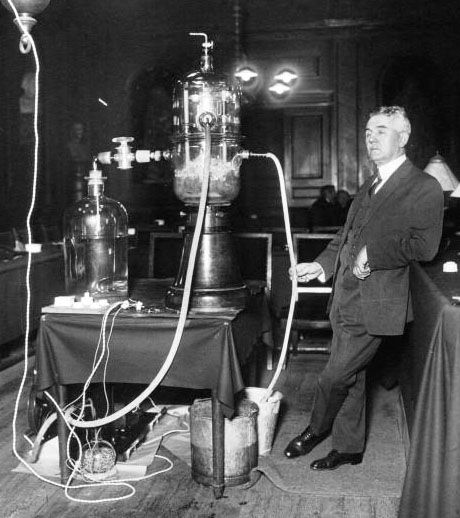
i
Georges Claude, a French chemist and engineer, injects glass tubes with noble gases, including neon, to create the first neon lights.
Claude’s neon lights gain considerable attention when they are used to illuminate a peristyle of the Grand Palais during the Paris Auto Show. 6
Seeing potential advertising applications, Jacques Fonseque, an assistant to Claude, begins shaping neon tubes into letters and symbols.
Claude’s first commercial neon sign is posted over a barbershop on Boulevard Montmartre, in Paris, with the words PALAIS COIFFEUR.
The Hong Kong colonial government enacts the Advertisement Regulation Ordinance to regulate the use of advertisements ‘which affect injuriously the amenities of any public place or disfigure the natural beauty of a landscape or of the waters of Hong Kong or of the clouds or sky’.
Claude begins to promote his tubes overseas and introduces them at the Congress of the Illuminating Society, in Pittsburgh, US. 7
Claude’s neon technology is successfully granted patents by the United States Patent Office,7 thus paving the way for a new era in advertising signage in the US.
Neon signs become recognised in Hong Kong after the government introduces Advertising By-laws that define ‘neon signs’ as ‘any arrangement of glass tubing charged with neon, argon, helium or other inert gas which when subjected to electrical pressure gives a bright glow, whether in the form of letters, characters, model, device, border or outline, designed to attract public attention to any building or place in which it may be affixed’. The By-laws also provide guidelines for erecting neon signs.
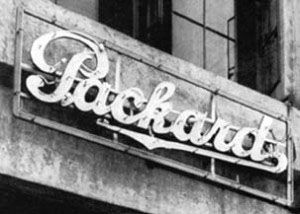 Claude makes his American debut with a pair of neon signs for a Packard car dealership in Los Angeles. 9
Claude makes his American debut with a pair of neon signs for a Packard car dealership in Los Angeles. 9
Claude Launches Neon EmpireNearly monopolising neon sign technology and production, Claude expands his reach by setting up Claude Neon Light Inc. in New York. He soon franchises his operations to Chicago, Los Angeles, San Francisco, Detroit, Pittsburgh, Boston, Casablanca and Shanghai. 10
In New York, a so-called Neon War is soon waged as numerous neon companies, including one called Rainbow Lights Inc., emerge in defiance of Claude’s patents.11
The first neon sign appears in China, advertising Royal typewriters in a window display at the Evan Book Company (伊文思圖書公司) on Nanjing East Road in Shanghai.
The bilingual neon sign installed at the Shanghai Central Hostel (上海中央大旅社) becomes the first sign produced in China. It’s made by the Shanghai Far East Chemistry Company (上海遠東化學製造廠).13
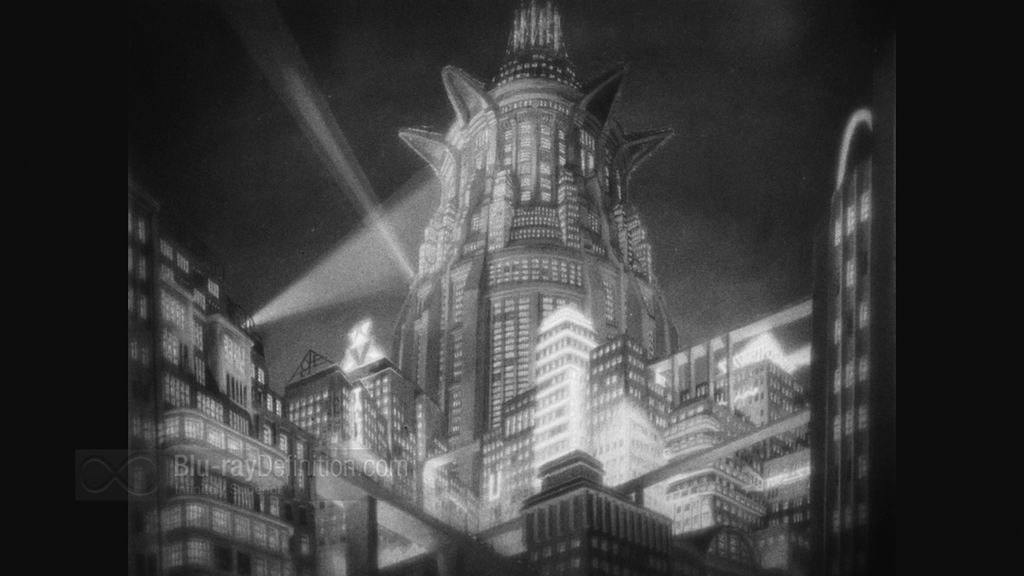
ii
Metropolis, the classic German science-fiction film directed by Fritz Lang, applies neon lighting effects to evoke a futuristic vision of the city.
Published in the US, Claude Neon News boasts of Claude’s triumphs while issuing stern warnings to those who would violate his patents. 12
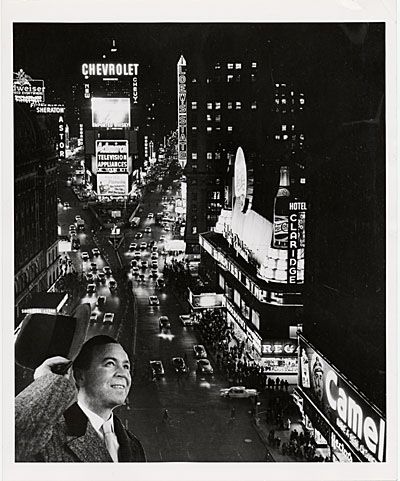 xxi
xxiIn New York, Broadway and Times Square begin their transformation into one of the most spectacular neon assemblages in history. Many of the area’s most iconic signs are the work of the advertising executive and lighting designer Douglas Leigh. The prominence of neon at the ‘Crossroads of the World’ helps promote the technology’s use as an advertising medium internationally. In Hollywood, neon lights symbolise glitz and glamour in films such as Gold Diggers (1933), directed by Mervyn LeRoy, and Ray Enright’s Dames (1934), which portrays fashionable women playing neon grand pianos and primping in front of neon mirrors. 14
Growth in China and Hong Kong The electricity converter for neon tubes is produced in China for the first time. 18 However, most of the equipment and gases needed to make neon signs are still imported from abroad.
Throughout the decade, the neon sign industry will boom in Shanghai, expanding its influence throughout the country, especially in coastal cities.
First Neon Factory in Hong Kong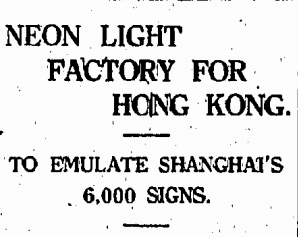 Responding to increasing demand, Claude Neon Light opens a factory in Hong Kong. Previously, most of the city’s neon signs were produced in Shanghai. 19
Responding to increasing demand, Claude Neon Light opens a factory in Hong Kong. Previously, most of the city’s neon signs were produced in Shanghai. 19
Masaru Ibuka, a future Sony co-founder, demonstrates ‘running neon’ at the Paris Exhibition, an international science fair. Producing an animated, flashing effect, his invention wins the exhibition’s highest honor. 15
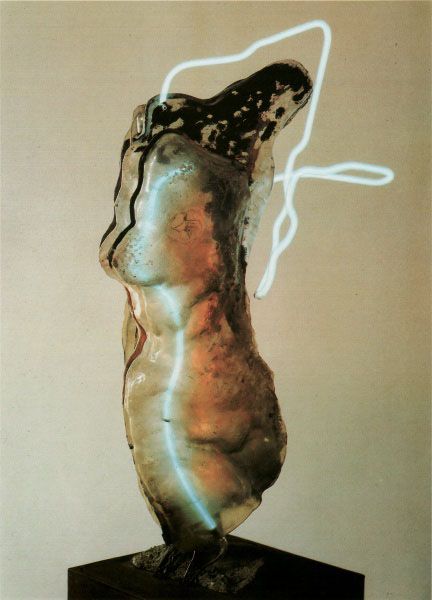 Czech artist Zdenĕk Pešánek creates the artwork Fontána lázeňství (‘Spa Fountain’), which is shown the following year at the Czechoslovak Pavilion at the 1937 Paris International Exhibition. The fibreglass sculpture of a torso employs neon and responds to the exhibition’s theme of ‘art and technology in modern life’. 16
Czech artist Zdenĕk Pešánek creates the artwork Fontána lázeňství (‘Spa Fountain’), which is shown the following year at the Czechoslovak Pavilion at the 1937 Paris International Exhibition. The fibreglass sculpture of a torso employs neon and responds to the exhibition’s theme of ‘art and technology in modern life’. 16
Neon Tubes in Nazi Propaganda Also at the Paris International Exhibition, an illuminated neon swastika projects Nazi strength and technological advancement at the German Pavilion. In Berlin, the Nazi newspaper Die Braune Post marks its headquarters with a large neon sign — though by 1940, it will go dark as the Nazi regime orders a nationwide blackout to protect German cities against Allied air raids. 17
Safety issues are raised in Hong Kong after a neon sign catches fire on Des Voeux Road. The following year, a ban on neon signs during typhoon weather is introduced. 20
As Japan invades China during World War II, the latter’s neon industries go into a slump. Many neon factories close, and lighting restrictions are imposed to defend against nighttime aerial bombardment.
The nighttime lights of Times Square, and in cities all along the East Coast of the US, are ordered blacked out as a precaution against possible German bombing. 21
World War II ends, ushering in an era of social, technological and other shifts that begin to make neon signs obsolete in the US. However, neon signs will gain ever greater prominence in Hong Kong in the postwar era.
World War II ends, ushering in an era of social, technological and other shifts that begin to make neon signs obsolete in the US. However, neon signs will gain ever greater prominence in Hong Kong in the postwar era.
Neon in Popular Culture 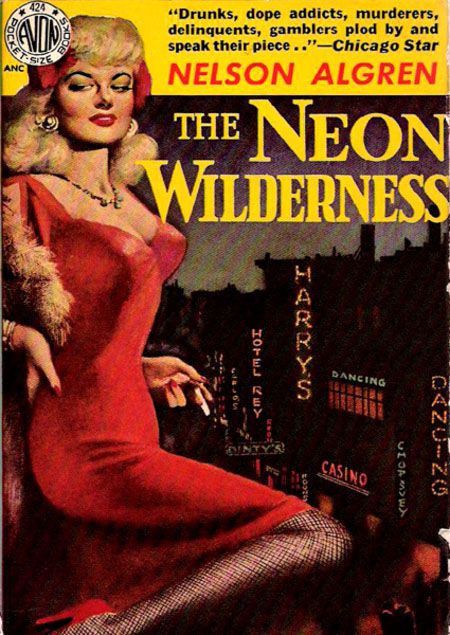
After the razzle-dazzle of the 1930s, neon’s representation in Hollywood takes a darker turn. Films such as I Wake Up Screaming (1941), directed by H. Bruce Humberstone, and Frank Capra’s It’s a Wonderful Life (1946) — alongside novels such as Nelson Algren’s The Neon Wilderness (1947) — use neon to evoke violence, crime and destitution. 23
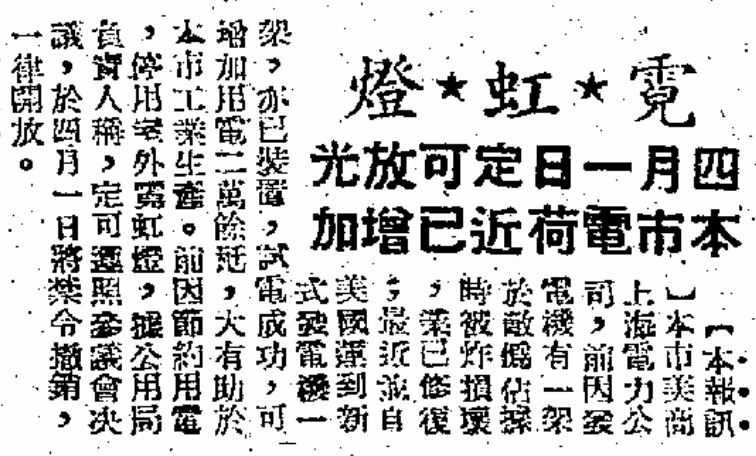
iii
In Hong Kong, the use of outdoor neon signs is suspended temporarily as the city works to recover from the damage done to its electricity infrastructure during the Japanese occupation in World War II. 24
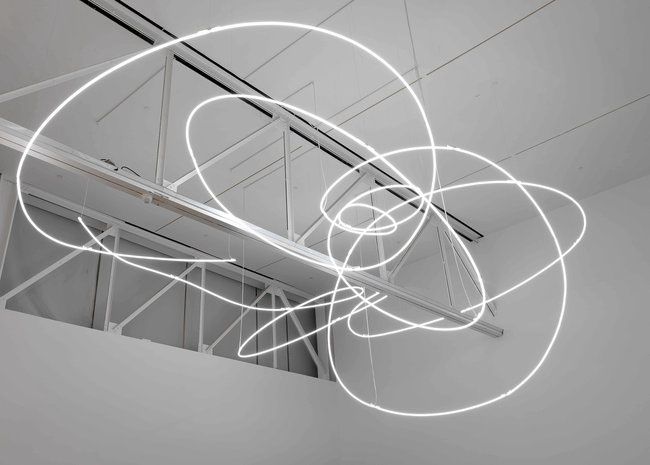
Italian artist Lucio Fontana installs his groundbreaking work Ambiente Spaziale a Luce Nera (‘Black Environment’) at the Naviglio Gallery in Milan. A giant amoeba-like swirl of neon is suspended in a darkened space to create an immersive environment. 22
Hong Kong’s Governor-in-Council submits a proposal to the Urban Council asking that neon signs be licensed — for a fee of $100 per annum for the first 20 square feet, and an additional $100 for every 10 square feet thereafter — in order to generate revenue for the government. However, due to technical difficulties in implementation and resistance from the neon industry, the proposal will be dropped in 1950.  iv
iv
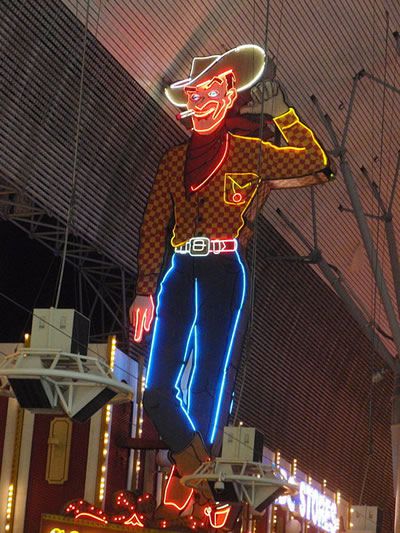 v
v 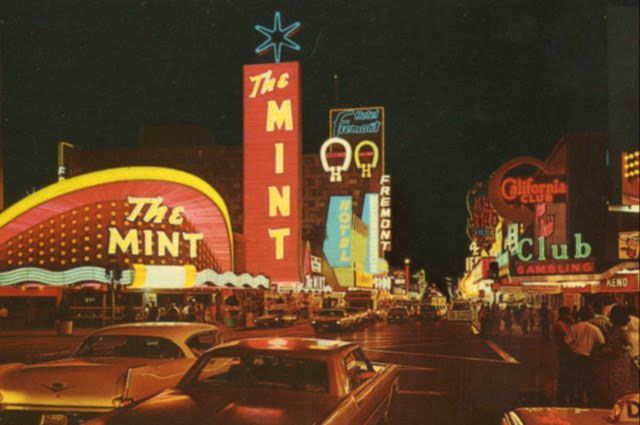 Though neon is fading elsewhere in the US, the gambling capital of Las Vegas becomes a ‘totally neonised’ city. 25 Significant neon installations include the Horseshoe Hotel and Casino’s massive neon-and-light-bulb horseshoe; the neon-lit façade of the Mint Casino, topped by a neon star; and ‘Vegas Vic’, a 15-metre-high neon cowboy on Fremont Street, whose girlfriend ‘Vegas Vicky’ is installed across the street from him in the 1980s. 26
Though neon is fading elsewhere in the US, the gambling capital of Las Vegas becomes a ‘totally neonised’ city. 25 Significant neon installations include the Horseshoe Hotel and Casino’s massive neon-and-light-bulb horseshoe; the neon-lit façade of the Mint Casino, topped by a neon star; and ‘Vegas Vic’, a 15-metre-high neon cowboy on Fremont Street, whose girlfriend ‘Vegas Vicky’ is installed across the street from him in the 1980s. 26 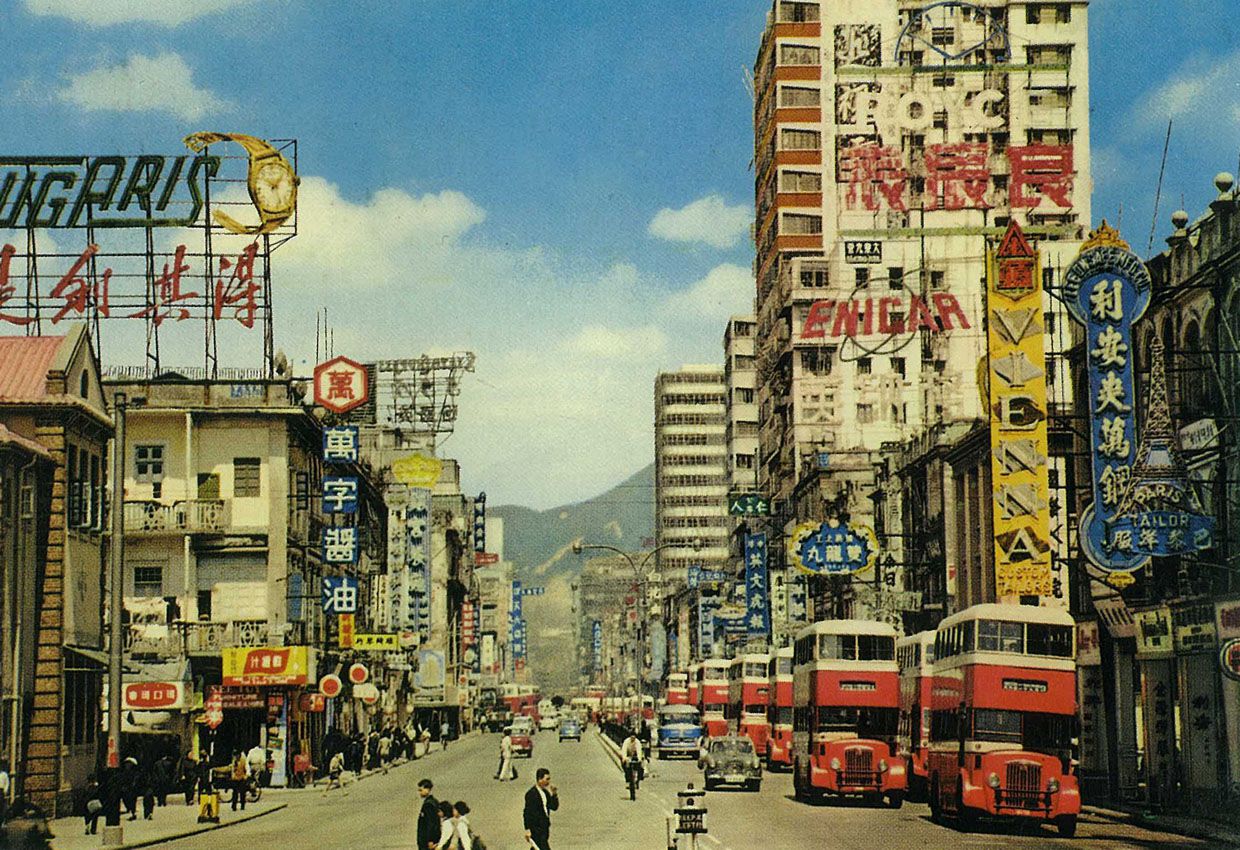 vii
viiThe neon industry is booming in Hong Kong, with manufacturers such as the Cathay Neon Light Company and Neco Neon Co 28 competing for business with large numbers of smaller workshops. 29
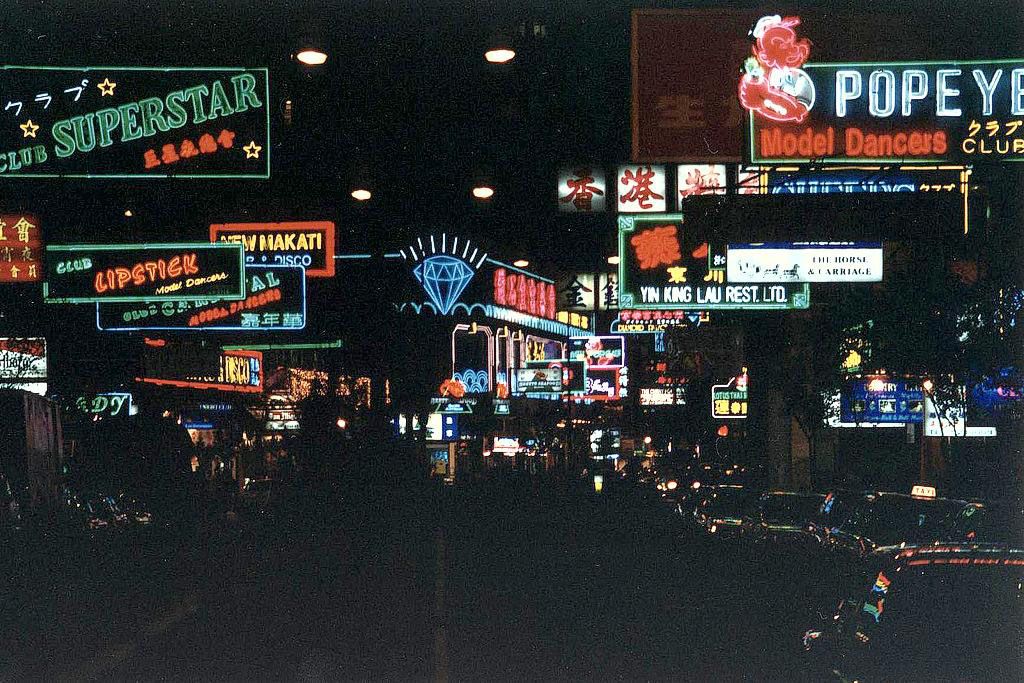 viii
viiiIn Hong Kong’s Wan Chai district, the neon streetscape of Lockhart Road emerges in sync with the flourishing nightclub business as US warships make stops in the city during the Korean War (1950–53).
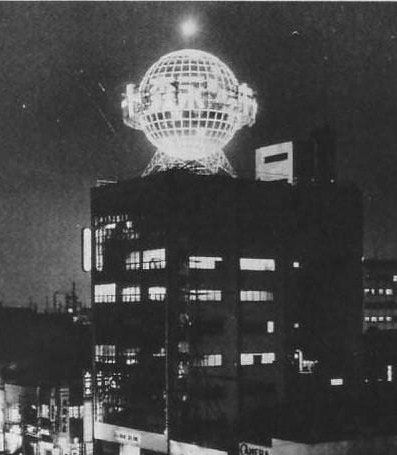
vi
In booming postwar Japan, the National Federation of Local Neon Sign Associations is formed to research, survey and provide safety guidelines and training to the neon sign industry. 27
Following the Chinese Civil War and the beginning of Communist rule, neon wanes in China. Nevertheless, a technological breakthrough comes when argon and neon gases are successfully produced in China for the first time. 30
In Hong Kong, the taxation of neon signs is once again proposed in the form of a flat rate of $100 per annum for each sign. However, in 1954, the Director of Urban Services shelves the idea.
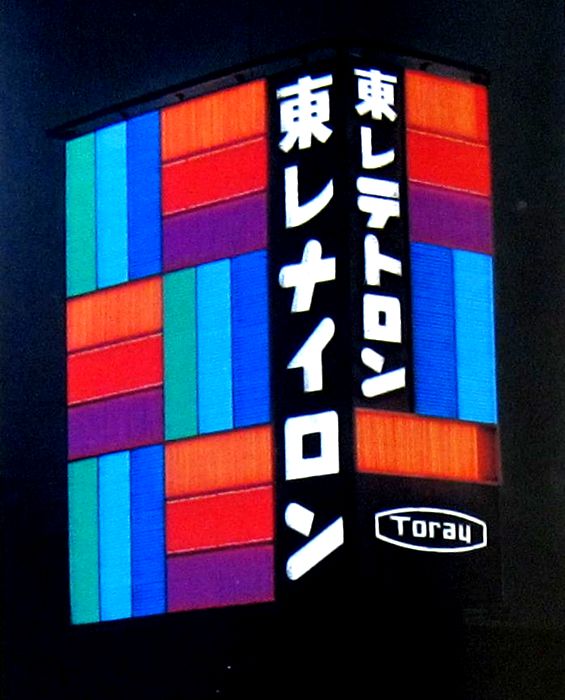 Renowned Japanese graphic designer Yusaku Kamekura designs an animated neon sign for companies such as Toray. It leads to other graphic designers taking on neon sign projects.
Renowned Japanese graphic designer Yusaku Kamekura designs an animated neon sign for companies such as Toray. It leads to other graphic designers taking on neon sign projects.
Neon signs appear in Cho Chong Yan’s (曹眾仁) novel Hotel (酒店) (1954), in which the bright lights of Nathan Road attract homeless refugees who drift into Hong Kong in search of a better life. 31
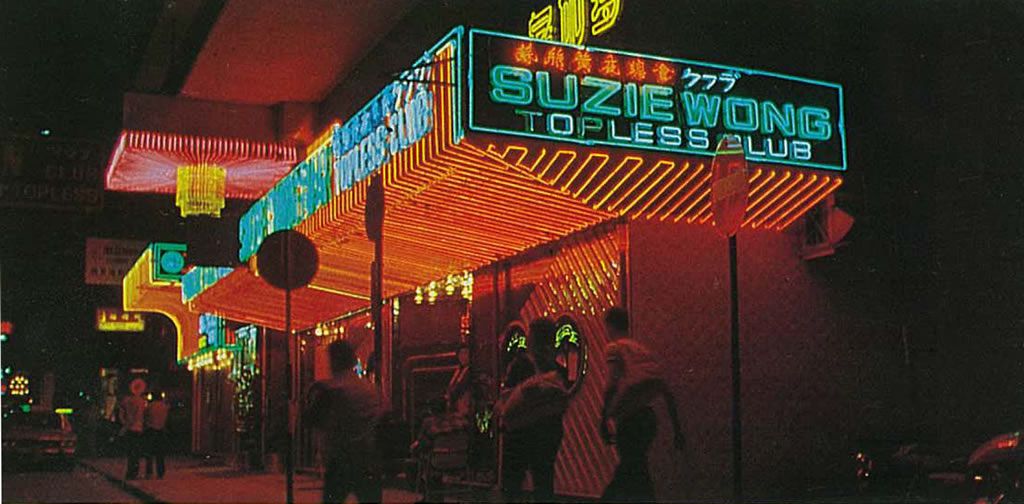
Richard Quine’s movie The World of Suzie Wong popularises Wan Chai as Hong Kong’s red light district. Later, in the 1970s, a nightclub in the area borrows its name from the film and becomes a local landmark.
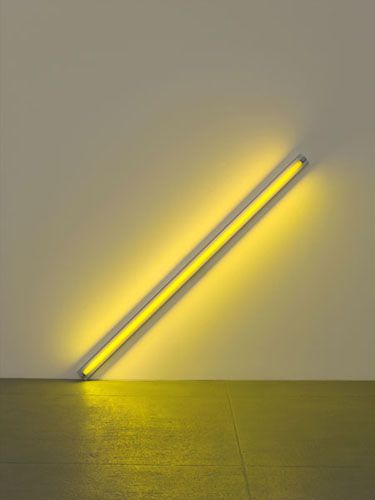
ix
Though using fluorescent (and not neon) light, artist Dan Flavin’s Diagonal of Personal Ecstasy (the Diagonal of May 25, 1963, to Constantin Brancusi) creates controversy in the New York art world, as some critics question its validity as a work of art. 45
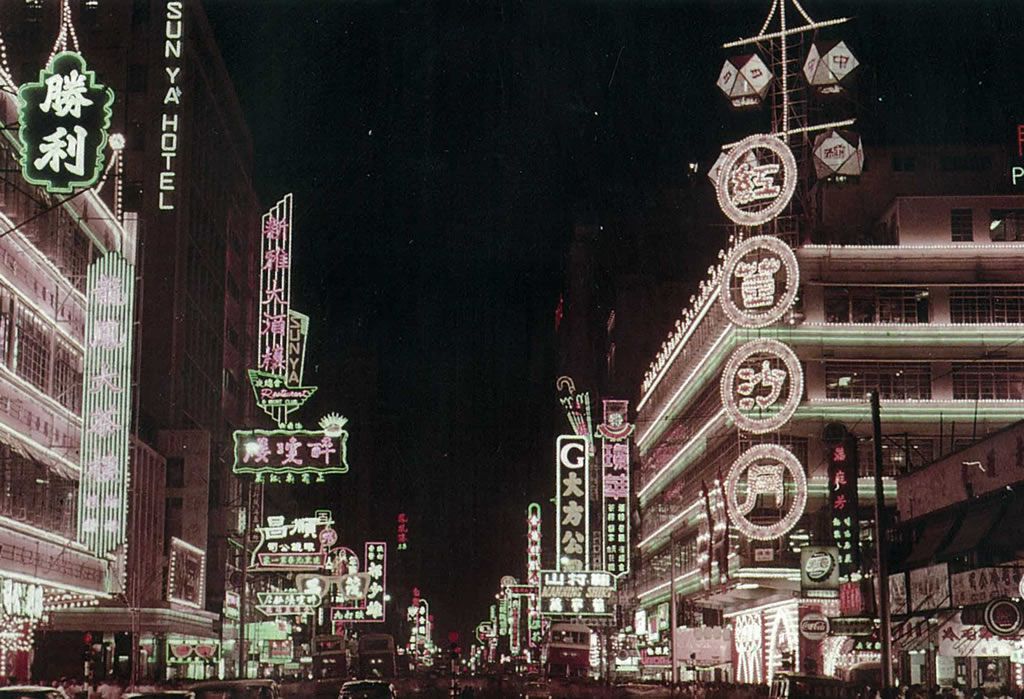
x
Large, multistory neon signs, like those for the restaurants Loog Fung, Sun Ya and King Wah, shape a spectacular neon streetscape on Hong Kong’s Nathan Road.
In New York, the National Electric Sign Association (NESA) launches a series of ‘Scrap Old Signs’ initiatives to dismantle signs considered worn-out and obsolete. 34
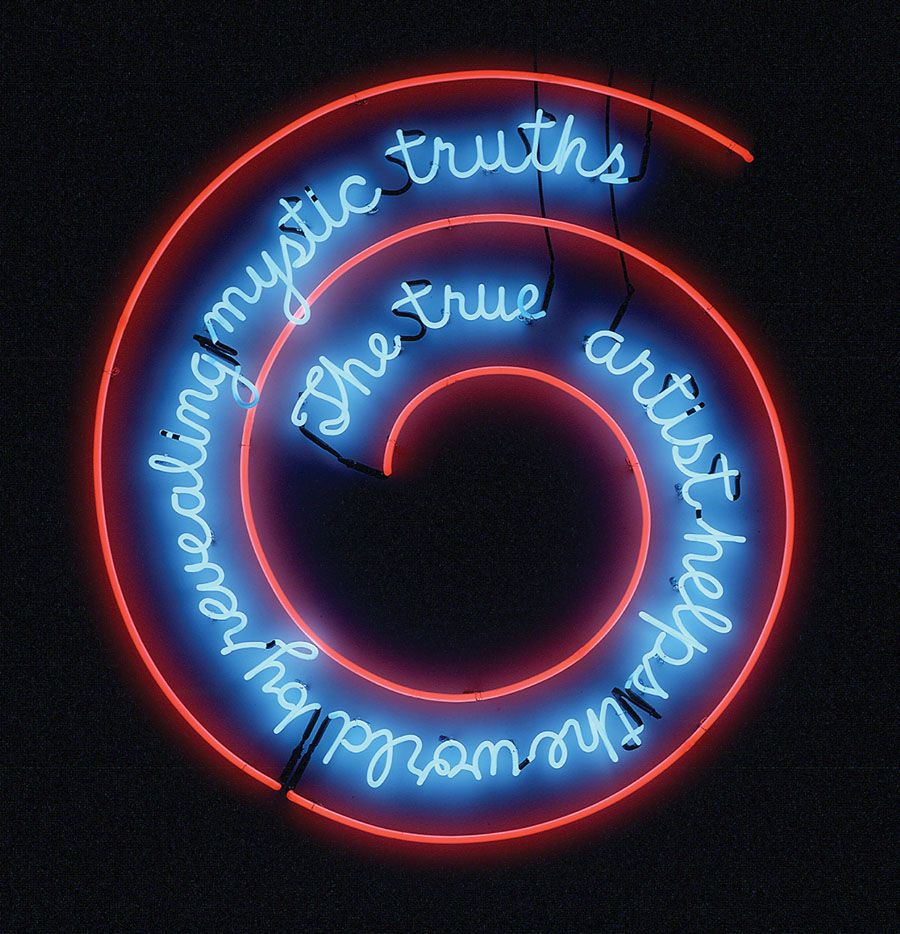
American artist Bruce Nauman creates The True Artist Helps the World by Revealing Mystic Truths using neon text as a poetic fragment. 35
Like most businesses throughout Hong Kong, the neon industry slumps during the riots and social disorder of this year. 36
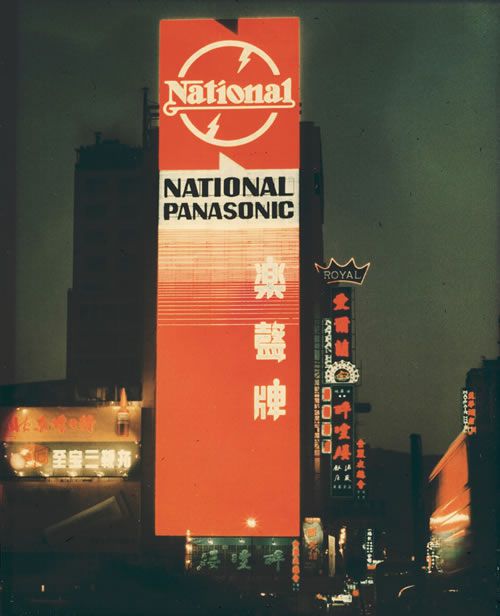 xii
xiiThe National Panasonic sign is the biggest neon sign in Hong Kong — and the world. Covering the entire side of a building on Nathan Road, it breaks the Guinness World Record for its size.
In New York, the storied Eddie’s Glass and Neon Institute (Egani), founded in 1930 to train neon workers, closes its doors.
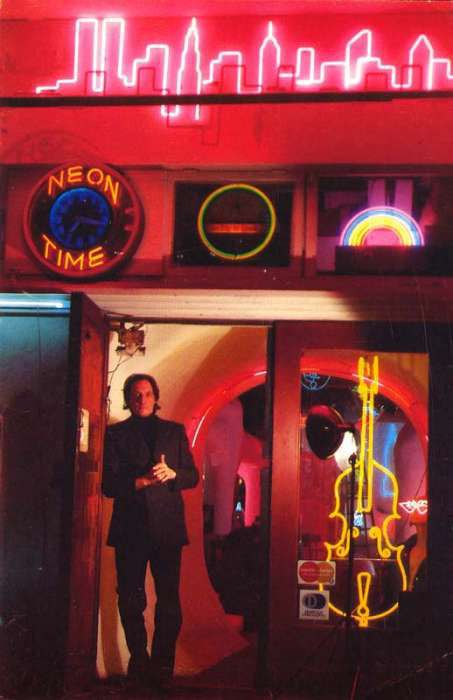
xi
Rudi Stern opens his influential gallery Let There Be Neon in New York to promote neon signs as an art form. 37
The All Japan Neon Sign Association cooperates in the effort to save energy in Japan during the Arab Oil Embargo. They also portray neon signs as an energy-saving advertising medium. 38
The Arab Oil Embargo prompts energy shortages around the world. In Hong Kong, neon sign owners are advised by the Petroleum Policy Committee (石油政策委員會) to shorten their signs’ illumination time to save electricity. 39
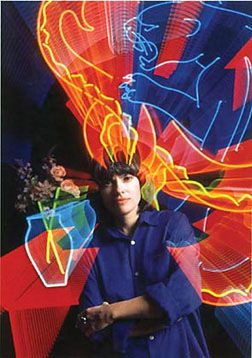
xiii
Light artist Lili Lakich founds the Museum of Neon Art in Los Angeles to highlight the art of neon and the skill of its makers.
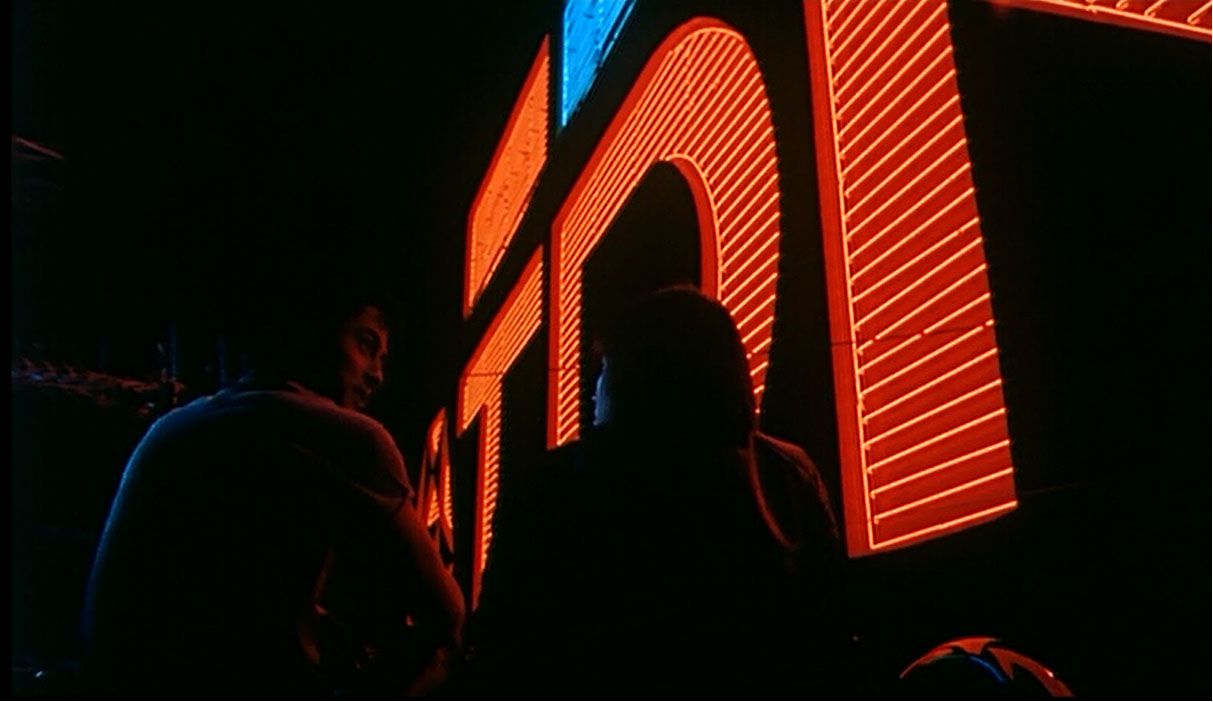
xiv
In the film Devoted to You (1986), director Go Chi Sum depicts the sensual and mysterious side of a glamorous city by setting scenes under the massive glowing signs on Hong Kong’s rooftops.
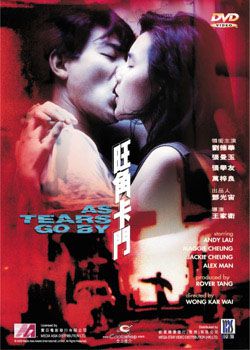
The movie As Tears Go By (1988), directed by Wong Kar-Wai, makes use of neon light to create a sinister atmosphere.
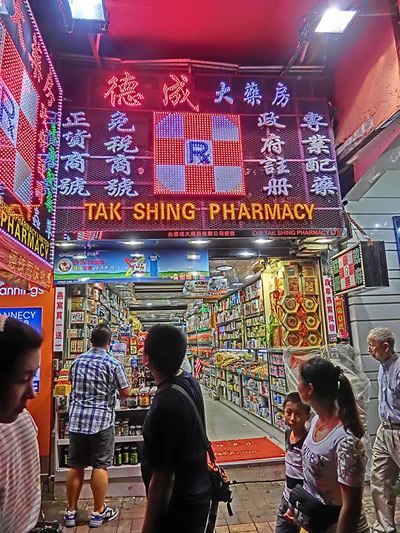 xvi
xviThe emergence of more energy-efficient LEDs accelerates the decline of neon in Hong Kong. Other competing advertising media, such as ink-jet billboards, also begin to dominate as neon is gradually relegated to indoor decoration.
With mainland China’s economic boom in full swing, the China Illuminating Engineering Society calls for the first national Neon Light Technology Conference. At the same time, the group establishes a national Neon Academic Organisation to boost the development of the neon industry. 40
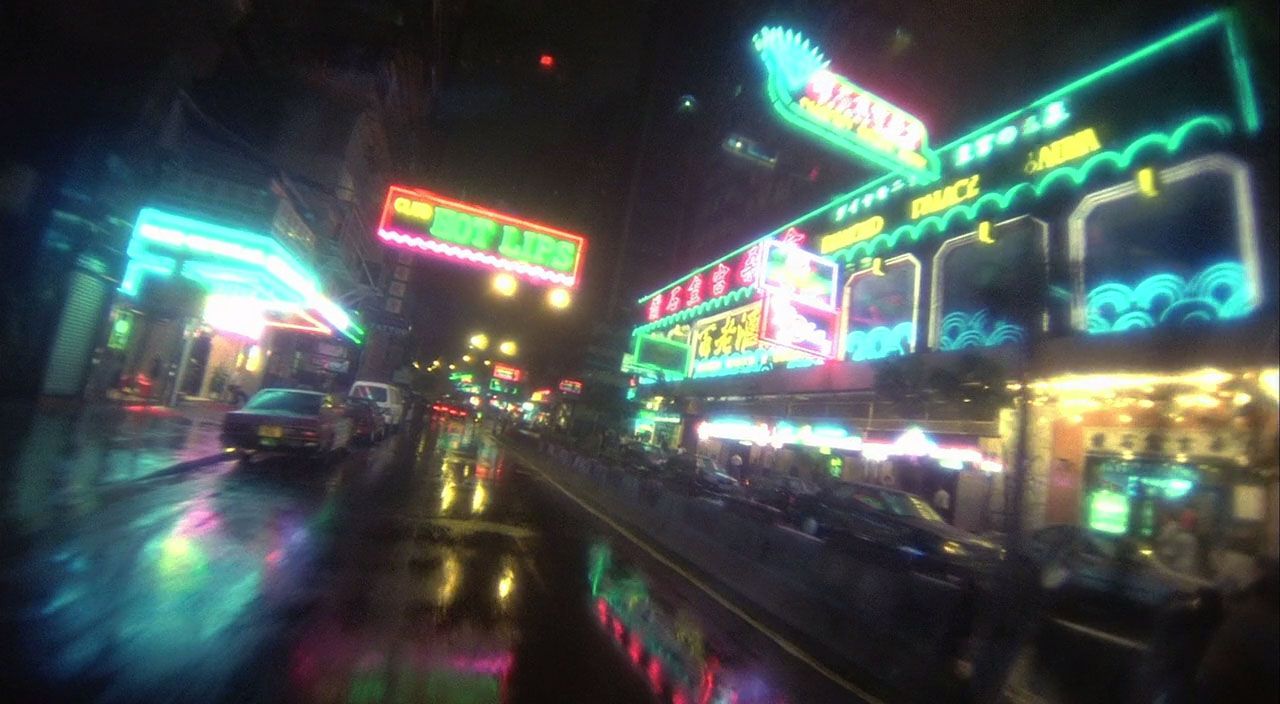
xvii
Director Wong Kar-Wai releases Fallen Angels, which prominently features neon lighting as an ambient visual element.
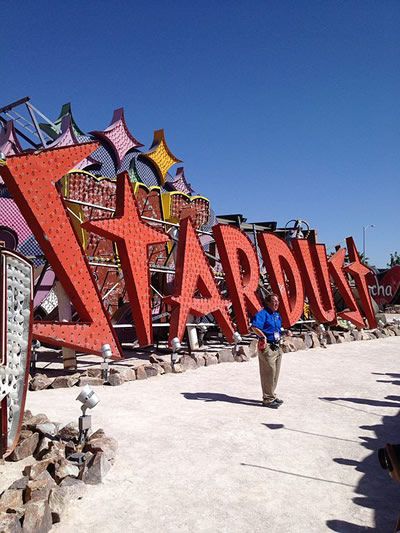
xv
The Neon Museum is founded in Las Vegas, dedicated to preserving, studying and exhibiting iconic Las Vegas signs. Among its initiatives is an outdoor ‘Neon Boneyard’.
In Tokyo, the Association of Qualified Neon Sign Engineers organises a series of festivities in June to celebrate its 30th anniversary. Among the events is a coordinated ‘performance’ for which shops in the Ginza district turn off their neon signs for 15 minutes.
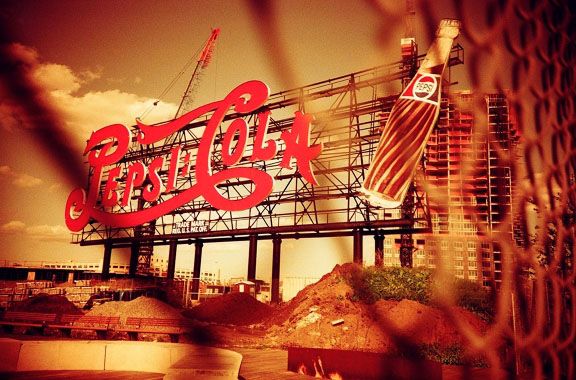 xviii
xviii
Pepsi sells its factory on New York City’s East River to a developer. But the factory has been topped by a massive Pepsi-Cola neon sign since 1936, and seeing its continuing marketing value, the company retains part of the site so the sign can be reinstalled later.
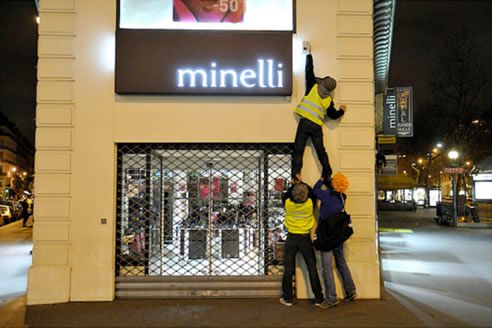
A French environmentalist group called Clan du Néon protests advertising lighting under the slogan: ‘For cities of light, against neon cities.’ Among other activities, its members furtively shut off illuminated signs in order to save energy. 41
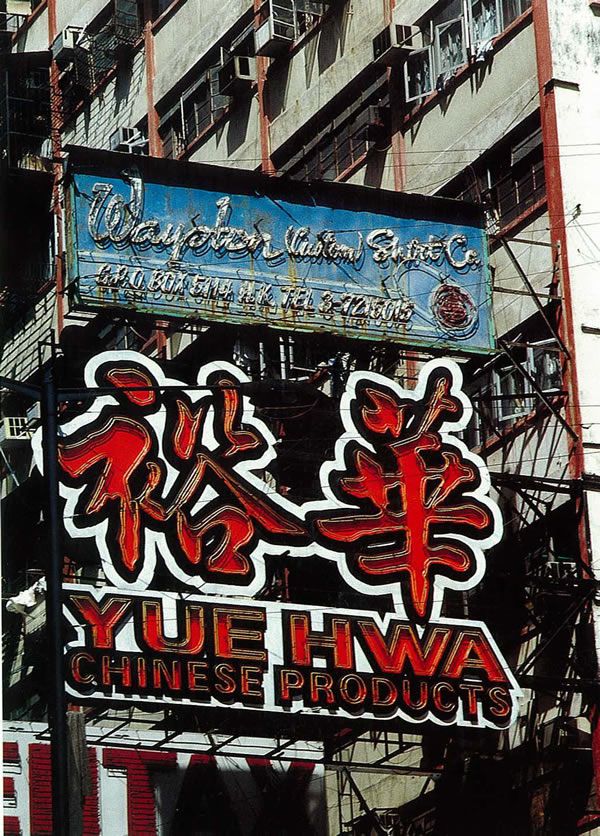
xix
Without warning, the iconic Yue Hwa Chinese Products neon sign in Hong Kong is removed from the intersection of Jordan and Nathan roads, after presiding there for decades in Hong Kong.
In Hong Kong, a number of emergency reports on street signs are received, raising a public safety issue. The Building Department removes approximately 3,000 unauthorized signboards per year. 42 In 2009 alone, more than 5,000 signboards are removed. 43
Under increasing public pressure over ‘light pollution’, Hong Kong’s Environment Bureau issues ‘Guidelines on Industry Best Practices for External Lighting Installations’. The voluntary guidelines suggest ways of reducing light emissions.
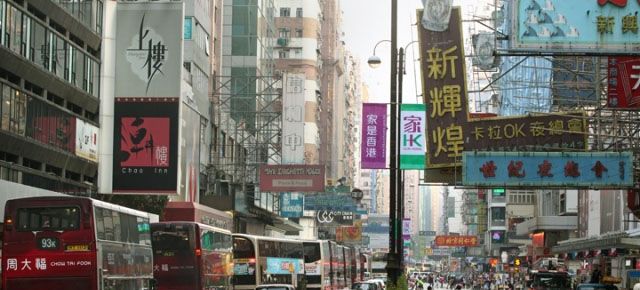
xx
In September, Hong Kong’s Validation Scheme for Unauthorised Signboards goes into effect, further speeding the disappearance of neon signs from the city’s streets. Removal begins on outdoor hanging ‘chandelier’ signs that exceed specified dimensions.
Further highlighting safety issues, a precariously hanging neon sign on Nathan Road forces the street’s closure in October. The Buildings Department estimates that there are approximately 120,000 signboards in the city, most of which are unauthorized.
A residential tower is completed along New York’s East River, on the former Pepsi factory site. The work of well-known architecture firm Arquitectonica, the building is designed to highlight views of the iconic 1936 Pepsi-Cola neon sign that originally stood on the site and has now been reinstalled there.
